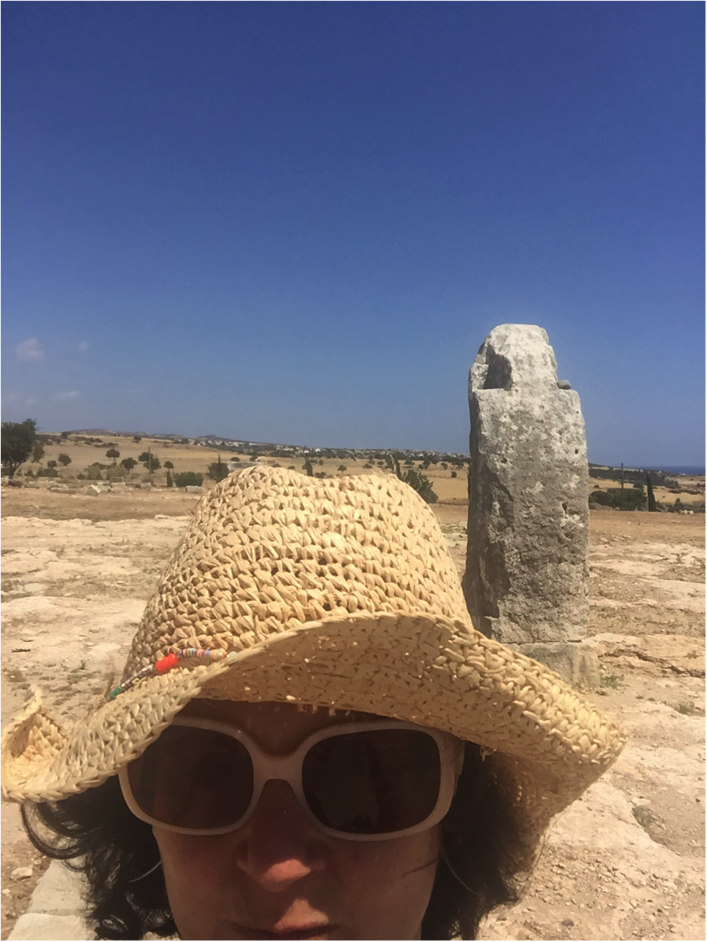Excavating in Kouklia, Cyprus

Nothing beats visiting archaeological sites and taking part in live excavations. While working on digitising the material from the Kouklia 1950s excavations in our collections I contacted Professor Maria Iacovou from the University of Cyprus about the Palaepaphos Urban Landscape Project (PULP) and current excavations at Kouklia in Cyprus as part of my documentation. I was delighted when Maria kindly invited me to visit the site and meet members of the team. I had only known the site of Palaepaphos from the archive photographs of the St Andrews University and Liverpool Museums 1950-55 excavations. Mitford and Iliffe who led the excavation at the time mainly dug in the Marchello area, part of the Evreti and Skales tombs and as well as briefly the Hadjiabdoullah plateu, the area they named as the palace.

Manor House now used as the Museum building at Kouklia.
The excavations by Professor Maria Iacovou and the University of Cyprus have recently concentrated on the areas of Hadjibdoullah and the Laona man made tumulus. The Hadjiabdoullah, plateu (east of the sanctuary of Aphrodite) was an extensive storage-plus-industrial complex of the Cypro-Classical period. It was built in stone and extends over 5 m along the plateau’s northern edge. It consists of stepped terraces built down the slope; it is subdivided into production and storage units by means of long cross-walls and parallel retaining walls. The area most likely functioned as the centre of the royal dynasty that ruled the city-state of Paphos until the end of the 4th century BC.

The sites in Kouklia © PULP
As it is to be expected agricultural products (olives, grapes, wheat etc.) found in the plateau confirm its use as a handling and storage complex. The excavation team has come across a surprising discovery of primary significance for the economy of the ancient polity: a thick layer of crushed murex shells was found lying on the floor of one of the units. It is the first time that archaeological data confirm the production of the precious and expensive purple dye (from the murex shells) in Cyprus. Previous geophysical and archaeological investigations conducted in the context of the Palaepaphos project also confirmed that the Laona mound, situated 75m north of the Hadjiabdullah complex, is a man-made tumulus of significant dimensions (100x60m.). Its summit rises to 114.20m. above sea level (almost 10m above the natural hillock).

Excavated murex shells.
The tumulus is a mortuary monument built in order to preserve the memory of renowned individuals, but it is extremely rare in ancient Cyprus. This and its unusual construction with thick horizontal layers of marl alternating with layers of red soil, make the Laona tumulus a special if not unique monument in the Cypriot landscape. Contrary to the red soil, which could be collected from the surrounding surfaces, marl had to be quarried from its geological environment, and then transported (probably, by means of carts) to where the mound was raised. It has been estimated that the construction of the tumulus required 9.888 cubic m. of marl and red soil.

The Laona tumulus.
My visit was short but important as I can now understand the site better, view recent excavation material and network with fellow archaeologists. I am indebted to Professor Maria Iacovou for her hospitality and for teaching me so much in a short amount of time. All the members of her team are enthusiastic and talented and worked hard despite June’s heat. Many of the students and specialist archaeologists have worked together for a number of years and they are now really a family. I felt so privileged to be a member of their team even if it was for a short time. I put some of my knowledge of Ancient Cypriot pottery to test going through the sherds from the excavation with the guidance of the pottery specialist Anna Georgiadou. I had long discussions with Anna about her research on the different pottery workshops of Iron Age Cyprus and what they tell us about the interactions among the different kingdoms. Anna kindly gave me a lift back to Nicosia with a quick stop to meet the American archaeologist Catherine Kearns from the University of Chicago starting her excavation with her students in Kalavassos.Cyprus is a fascinating place for archaeology and you get to meet everyone so quickly.

Me helping out in the excavation headquarters.
While the archaeologists rested I visited the sanctuary site of Aphrodite, originally constructed early in the 12th century BC, where the Cypriot Goddess (the Kypris) was worshipped. This megalithic Sanctuary continued to function as a place of adoration for a female deity down to the Roman era. In historic times, the deity became known as Aphrodite. The Kouklia museum close to the sanctuary is an impressive building: the old Manor House erected by the Lusignans in the 13th century. This house is featured in many of the archive excavation photographs of Mitford and Iliffe excavation’s in the 1950s and served as the base for that team. We have two bodies from the limestone sculpture, as well as the Head of Priest King and a female head that were discovered in site KA from the St.Andrews University and Liverpool Museums excavation so it was amazing to see more pieces from the excavation. The ivories and stone vessels on display in the museum also relate to the same group as our collections. It is notable that the sculpture discovered in the 1950s has still not been published in its entirety. It would be wonderful one day to have a complete catalogue to bring the material together at some point. You can view highlights from our Ancient Cyprus collection online, including material from Kouklia.

The sanctuary site of Aphrodite.
